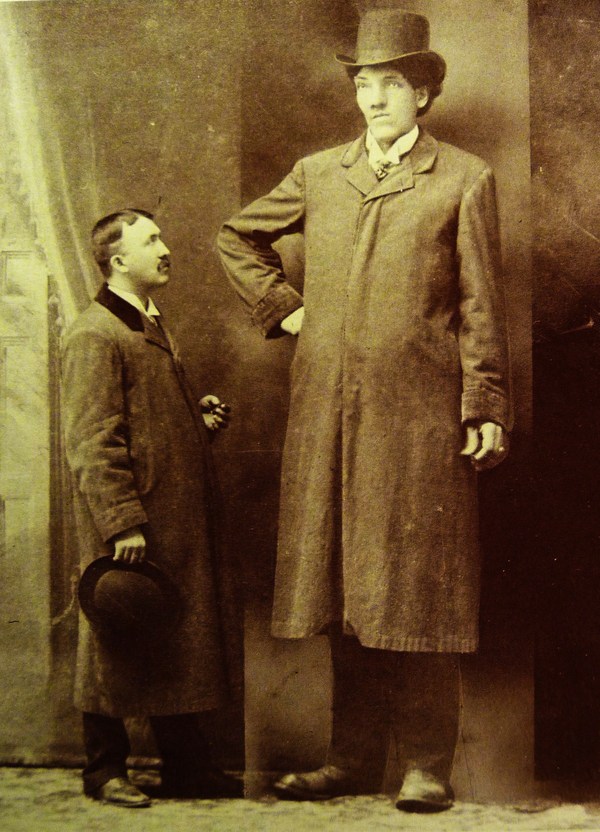
Source: Courtesy of Wikimedia Commons
BEAUPRÉ, ÉDOUARD, known as Beaupré the giant, a strong man and legendary figure; b. 9 Jan. 1881 in Willow Bunch (Sask.), eldest of the 20 children of Gaspard Beaupré, a native of L’Assomption, Que., and Florestine Piché, a Métis woman who with some 60 families from the Red River settlement (Man.) had fled to Willow Bunch during the 1870 uprising; d. 3 July 1904 in St Louis, Mo.
Legend has it that Édouard Beaupré weighed between 9 and 14 pounds at birth. His growth was normal until he reached the age of seven, but he began to grow rapidly soon after he started school. At nine he was nearly 6 feet tall, at twelve 6 feet 6 inches, and at seventeen 7 feet 1 inch. He attended school off and on for four years. He never had more than a rudimentary education and, according to an article published in 1967, “it was alleged, even by those closest to him, that he was as dull as he was tall.” He was not stupid, for all that. He learned to carry on conversations in French, English, Cree, Sioux, and Michif.
During his adolescence Beaupré was awkward, a little naïve, and disconcertingly silent. He felt at ease, not on a school bench, but out in the open on the ranches near Willow Bunch, where he learned to throw a lasso from two local cowboys, Johnny Chartrand and John Savary. Unfortunately he had to give up that work at the age of 17 because, according to tradition, when he rode a horse his feet touched the ground. About this time a horse kicked him in the face, breaking his nose and most likely other bones as well. The accident left him disfigured and his unsightly face, together with his gigantic size, intensified his feelings of insecurity.
Under the guardianship of André Gaudry, a Métis from Willow Bunch, Beaupré then began a tour of several Canadian cities, where he performed feats of strength, lifting a 600-pound horse on his shoulders and bending iron bars. Between tours he always returned home. However, there was not much profit and he had to keep going back on the road. After visiting a number of cities in the eastern United States, he lived in California for a year. The loneliness and boredom that gnawed at him between shows drove him to drink, often to excess.
Beaupré went back east and with his father visited New York and other cities. Returning to Montreal, he took on the Quebec strong man Louis Cyr* in Parc Sohmer on 25 March 1901. Cyr won easily, although the supporters of Beaupré the giant claimed that he had been weakened by tuberculosis and was only a shadow of his former self.
Beaupré then decided to resume working as a cowboy and moved to a ranch in Montana. But tuberculosis had undermined his strength and endurance, and the state of his health forced him to give up his work. He went on tour again, this time with the Barnum and Bailey Circus. During a show at the Louisiana Purchase exposition in St Louis, he collapsed and died of a massive pulmonary haemorrhage on 3 July 1904, at the age of 23. At the time of his death he was 8 feet 3 inches tall and weighed 375 pounds. His was a case of pituitary gigantism and his height made him the fifth-largest known giant.
Following an autopsy, Beaupré’s body was turned over to the undertakers Eberle and Keyes for embalming and burial. The remains were to be sent to Willow Bunch, but the family was too poor to pay the transportation costs. The undertakers decided to recover their expenses by putting the body on display in a store window. The police authorities intervened to prohibit this spectacle. Pascal Bonneau, a businessman from Willow Bunch, went to St Louis and had the body sent to Montreal, where it was shown for more than six months at the entrance to the Musée Éden. So many curious spectators came that the municipal authorities stopped the visits.
In the spring of 1907 some children found Beaupré’s body in a shed at Parc Bellerive in Montreal. Apparently the circus that had been exhibiting it had abandoned it after going bankrupt. It was sent to the anatomy department of the Université de Montréal, where it underwent a special mummification process. It was then displayed in a kind of glass shrine at the faculty of medicine until the mid 1970s. Finally, at the request of some members of his family, Beaupré the giant was cremated and buried in Willow Bunch on 7 July 1990, more than 85 years after his death.
Sask. Arch. Board (Regina), 2.507; E1054. J.-M. Blais, “Men and books: Édouard Beaupré, 1881–1904,” Canadian Medical Assoc., Journal (Toronto), 96 (1967): 1647–53. Commission Culturelle Fransaskoise, Le géant Beaupré (Regina, 1986). Richard Lapointe, 100 noms: petit dictionnaire biographique des Franco-Canadiens de la Saskatchewan (Regina, 1988). Clovis Rondeau et Adrien Chabot, Histoire de Willow Bunch (Gravelbourg, Sask., 1970), 266–73.
Andre Lalonde, “BEAUPRÉ, ÉDOUARD, known as Beaupré the giant,” in Dictionary of Canadian Biography, vol. 13, University of Toronto/Université Laval, 2003–, accessed November 28, 2024, http://www.biographi.ca/en/bio/beaupre_edouard_13E.html.
The citation above shows the format for footnotes and endnotes according to the Chicago manual of style (16th edition). Information to be used in other citation formats:
| Permalink: | http://www.biographi.ca/en/bio/beaupre_edouard_13E.html |
| Author of Article: | Andre Lalonde |
| Title of Article: | BEAUPRÉ, ÉDOUARD, known as Beaupré the giant |
| Publication Name: | Dictionary of Canadian Biography, vol. 13 |
| Publisher: | University of Toronto/Université Laval |
| Year of publication: | 1994 |
| Year of revision: | 1994 |
| Access Date: | November 28, 2024 |